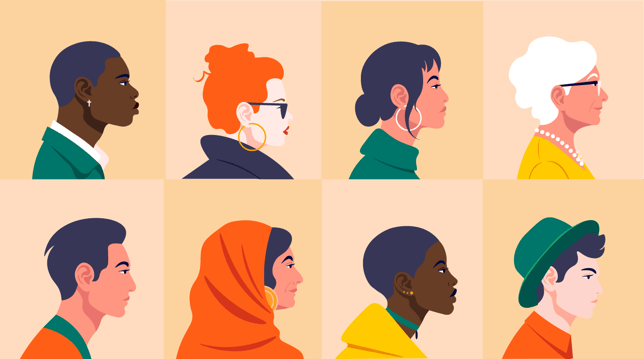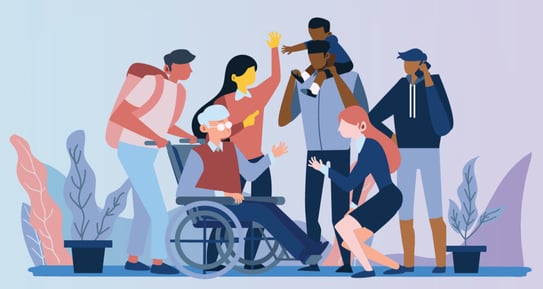5 min read
6 Ways to Handle Inclusion Bias and Embrace Diversity at the Workplace
Clay Walsh
Last Updated: 3 February 2023
Almost 7 years back, during my first semester at TISS, I had my first academic encounter with the word “bias.” It was our OB class, and the professor has announced that we are going to talk about different biases and how it affects our behavior at the workplace, or in any group for that matter.
After all the assignments, quizzes, projects, exams, and many years of conscious living, I have reached a conclusion that we all have different sets of biases. Over the years I have been trying to decode the impact of bias on our mindset and behavior, particularly in HR best practices and to improve diversity and inclusion in the workplace.
Today we’ll dive into more about what bias is, how it can negatively impact both your personal and professional performance, and 6 practices that you can implement to remove bias from your own thinking and strengthen your team’s HR practices.
- Defining What Bias Means Today
- How Does Bias Make an Impact at Work?
- 6 Ways to Reduce Bias at Work and in Life
Defining What Bias Means Today

If you look up the broad definition of bias, it refers to "a strong feeling in favor of or against one group of people, or one side in an argument, often not based on fair judgement.” But there’s more to it. Bias further can be divided into two categories - conscious bias and unconscious bias. Let’s take a look at those.
To understand the conscious and unconscious, first we have to decode the concept of conscious and unconscious mind. The conscious mind is logical and rational and reacts to any situation in life, while unconscious bias is a dam of feelings, urges and memories.
- In an organizational setting, conscious bias can be controlled easily. Organizations have zero tolerance towards discrimination and it’s legally protected which helps to control and monitor the behavior of your workforce. Contracts have been developed that allow for justifiable termination of employees who violate bias clauses, whether through racism, homophobia, or more, and organizations have made great strides in following through on them. Further, efforts to diversify leadership cores in companies around the world have helped bring new viewpoints to the table.
- But when it comes to unconscious bias, it’s exponentially harder to eliminate. For one, it’s shaped by our upbringing, our environment and social factors. What we experience or hear in our day to day lives will, psychologically, impact our ways of thinking and processing different groups of people. Why are unconscious biases so detrimental?
How Does Bias Impact Your Employee's Day-to-Day?
Unconscious biases are social stereotypes about certain groups of people that individuals form outside their own conscious awareness. Everyone holds unconscious beliefs about various social and identity groups, and these biases stem from one’s tendency to organize social worlds by categorizing. In turn things like negative stereotypes will shape personal and workforce practices, intentionally or not. Check out this UCLA sponsored study on how stereotyping and bias against certain names associated with different US racial groups impacts likeliness of hiring to learn more.
While there are 100+ unconscious biases, confirmation bias—probably the most pervasive and damaging bias of them all—leads us to look for evidence that confirms what we already think. It affects productivity, culture and speed in any organization, and limits you and your team from taking risks and making decisions with absolute clarity.
While we understand that unconscious biases are a reality, we can work to minimize the impact of these biases on our personal and professional habits, and in our org cultures, by following 6 simple steps.
6 Ways to Reduce Bias and Improve Performance at Work

1. Introspection as a Key to Success
Spend time with yourself, considering the biases that may impact your day to day thought processes. With this time, try and understand your own prejudices and what aspects which unconsciously shape your decision making processes.
How can we translate this to HR? Constant evaluation of both biases, and other factors, like motivation and personal engagement are all aspects worth considering. They all can have impacts on our performance, so taking some time to reflect on your own strengths and weaknesses, bias related or not, can help you self-evaluate and diagnose your own personal key focus areas.
Key Takeaways: Take time to look inward in order to both diagnose and rectify your own unconscious biases, and also practice honest self-evaluation when it comes to workplace performance.
2. Appreciate and Encourage Diversity
We all are different creatures. We have different upbringings, different cultural values and different belief systems. From both a personal and professional standpoint this is an asset in so many ways. Being exposed to diversity allows us to understand situations differently, remove biases, and change our ways of thinking.
In the HR context, there are ways you can both ensure diversity and leverage it to your advantage. First of all, diversity and inclusivity training are a key part of the modern work world, and if your team isn’t implementing them they should be! Second, encouraging a variety of viewpoints, from across the identity spectrum and organization, can create new solutions to problems by thinking about them in ways that people may not have before.
Key Takeaway: Diversity is both a necessity and advantage in today’s business world. By building a broad variety of viewpoints, opinions, and experiences you stand to leverage the most possible angles in solving common problems and moving key business levers.
3. Take Advantage of Globalization to Broaden Your Horizons
One inadvertent perk of the COVID-19 pandemic has been the huge amount of excellent webinars organized by organizations around the globe. While pre-COVID South East Asian events may have been inconvenient to North American audiences, or vice versa, now all you need to do is set an early (or late!) alarm to have a chance to sit in on conversations with thought leaders from around the globe. The advances in technology and our collective ability to adjust to the “New Normal” means we now have opportunities to learn from so many more people than we did before.
In HR, learning methods of thinking that companies in other countries might use effectively can help reduce your bias against other ways of doing business and implement best practices from other cultures and organizations.
Key Takeaways: The advent of global conferences and webinars as a result of the COVID-19 pandemic has given us all so many opportunities to learn from worldwide leaders, which in turns helps us fight biases and learn new best practices from around the globe.
4. Try Blind Recruitment to Mitigate Unconscious Biases
One tactic that many leading HR professionals are moving toward is blind recruitment. What does this entail? Removing any and all information which might create an unconscious bias during the interview process, including things like ethnic background, gender, name, age, education, personal interests, and more.
How does this help HR make better hires? By eliminating key indicators for biases you’re more likely to be able to empirically evaluate employees rather than get hung up on superfluous details that prevent a clear decision. Let’s say one potential candidate went to a rival university of yours. That might subconsciously impact your decision making! So cut out those key identifiers and watch your HR team hire more effective candidates.
Key Takeaway: Eliminating information that may cause bias in the hiring process, largely personal info, can help you empirically evaluate candidates and make more educated hires without clouded judgement.
5. Focusing On Gender Neutrality in Language
Have you ever noticed that examples always seem to use the word he? What about job postings? This is an unconscious bias that skews the advantage in the business world towards men. Women, when they see pronouns they don’t identify with, can often see this as a roadblock. So, what can you do?
Focus on using gender neutral pronouns in the workplace. Rather than use an example with words like “he” try using words like “they. This helps the organization learn a new language, widen their horizons, and also helps promote equity in hiring. Gender stereotypes play a huge role in employer branding and hiring practices at many organizations, so work to change that culture at your company.
Key Takeaway: Stay away from using men and male pronouns in all example scenarios, job descriptions, and other workplace communications. It promotes male dominance in a corporate environment, and can set up obstacles for women in the organization.
6. Implement Technological Solutions that Rely on Data, Not Bias
One excellent thing about HR tech and AI chatbots is that they are solely data driven. No identifying factors like age, gender, prior work experience, or more come into the algorithms. Rather, data and performance are tracked empirically using advanced analytics capabilities. While is an ongoing conversation around biases in AI, AI's strength is that it doesn’t see color, age, or gender, just real-time results and predictions using existing data. It’s the ultimate tool for eliminating bias in the workplace.
Key Takeaway: AI tools like HR chatbots are a foolproof way to eliminate bias as they are solely based on statistical analysis and data aggregation, which is free of preconceived notions or thought processes.
Over the past 7 years, I have witnessed a plethora of situations where unconscious bias kicks in and impacts decision making both inside and outside the workplace. But, after a lot of introspection, I’m happy I’ve been able to develop and share these simple steps that can help you be a better person and employee